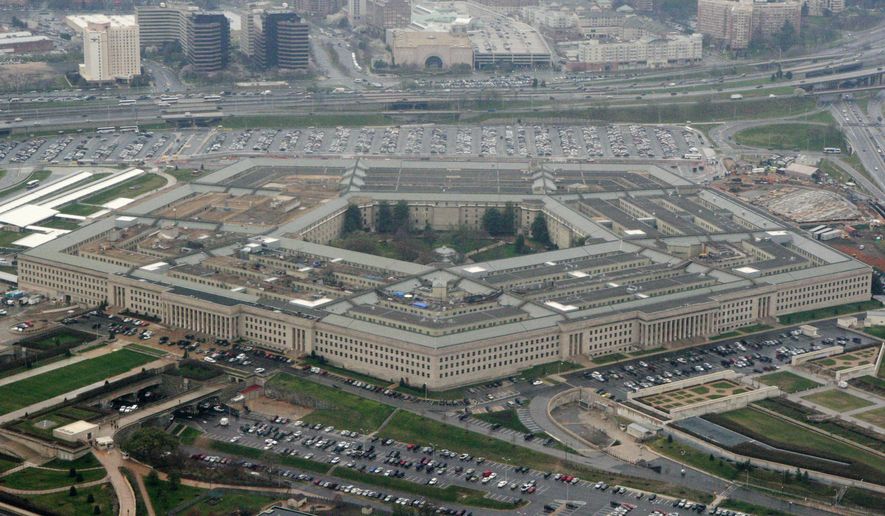The White House on Friday released its initial framework of President Biden’s proposed budget for fiscal 2022, which gives only a slight boost in funding for the Pentagon and a bigger increase for domestic spending programs in areas such as housing, climate change and gun control.
The total discretionary request includes $769 billion for spending on domestic priorities and $753 billion for defense — increases of 16% and 1.7% respectively compared with 2021.
The proposal includes $715 billion for the Pentagon — a slight uptick from the 2021 enacted level of $704 billion, but undoubtedly less of a boost than Republicans and defense hawks want to see.
“We certainly hope people look at the full scope here,” an administration official told reporters on a call previewing the request. “The focus will be on investments on non-defense but also ensuring the Defense Department can continue its strategic goals as we out-compete China and as we ensure that the men and women in uniform have everything that they need.”
A “large chunk” of the defense increase will go toward a pay increase for troops, the official said.
Liberal members of Congress, meanwhile, have pressed Mr. Biden to slash the Pentagon budget by at least 10%.
The initial outline gives a boost of more than $14 billion for climate change-related spending, a $20 billion increase for Title I grants for high-poverty schools, and a $232 million increase for gun-related initiatives at the Justice Department like improving background check systems and incentivizing states to adopt gun buyback programs.
Republicans said the defense spending levels need to be higher.
“This budget has no chance of being enacted, and is a waste of the paper that it’s printed on,” said Sen. Bill Hagerty, Tennessee Republican.
Rep. Ro Khanna, California Democrat, criticized the modest increase in defense spending and called for more of a focus on climate change and the coronavirus pandemic.
“Those are the issues impacting the security of the American people and will keep Americans safer than spending billions on more deadly weapons,” he said.
The White House is expected to release a more detailed 2022 budget request later in the spring.
The official described the figures as “separate” but “complementary” to the president’s $2.3 trillion infrastructure plan he rolled out last week.
The outline released on Friday does not include any of Mr. Biden’s planned tax increases that he wants to enact to partially pay for the new infrastructure spending.
The discretionary budget also does not include mandatory spending programs that are largely on autopilot, like Medicare.
The 2022 budget year, which starts on Oct. 1, is the first time in a decade that Congress and the White House won’t be living under strict budget caps that were a product of a deal brokered by former President Obama and then-Speaker John A. Boehner, Ohio Republican.
“Clearly, this president has seen the degradation of budget caps and what they’ve done — especially on the non-defense discretionary side,” the official said.
Congressional leaders struck a deal with former President Trump in July 2019 to increase the 2020 and 2021 spending caps by hundreds of billions of dollars and to suspend the debt ceiling until the end of July this year.
The discretionary budget for fiscal 2021 ended up being close to $1.6 trillion, after special emergency and war spending was added to the mix.
Congress typically ignores presidential budget requests, but they are among the clearest indications of where the administration wants to direct its spending priorities.
Presidents have generally given up on trying to submit proposals that provide a realistic path to balance over the typical 10-year budget window.
The federal budget deficit was $1.7 trillion for the first six months of fiscal 2021 - almost $1 trillion more than the same period last year, the Congressional Budget Office reported this week.
The president is supposed to release a formal budget blueprint by the first Monday in February every year, but that timeline can get delayed — particularly when there’s a transition to a new administration.
Still, Mr. Biden has waited longer than his recent predecessors to send an initial budget outline to Congress.
Mr. Trump released his initial budget on March 16, 2017, and Mr. Obama put out some of his budget numbers on Feb. 26, 2009.
“It took the Biden Administration longer than any other administration in the modern budget era to produce what is essentially a back-of-the-envelope bookkeeping exercise combined with a series of talking points and a troubling lack of transparency,” said Rep. Jason Smith of Missouri, the top Republican on the House Budget Committee.
Mr. Biden’s team said the Office of Management and Budget (OMB) was one office where members of the Trump administration were not helpful during the post-election transition period — an accusation that the Trump team denies.
“OMB was one of those agencies that we would have loved to see more historic cooperation during [the] transition,” an official said Friday. “The past administration did not allow the staff to work with us on budget development, which past administrations had done during transitions.”
The White House also had to nix the nomination of Neera Tanden, who the president named as his pick to lead OMB, after lawmakers raised concerns about her past social media attacks on members of Congress.
Shalanda Young, who the Senate confirmed as deputy OMB director, is serving as acting director.
• David Sherfinski can be reached at dsherfinski@washingtontimes.com.




Please read our comment policy before commenting.